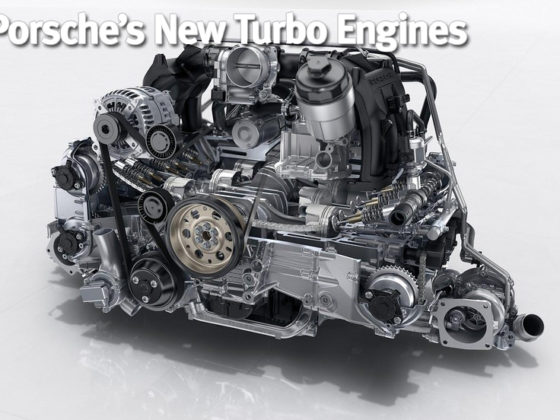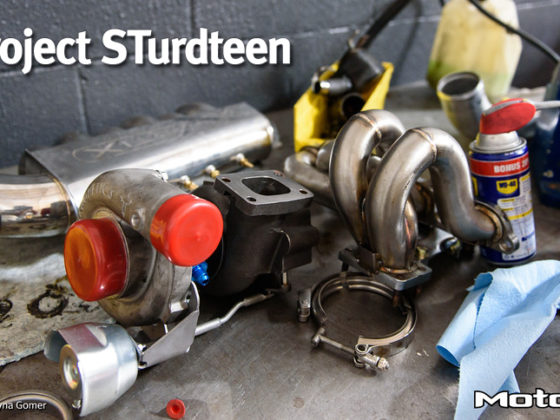,
 Most pro drift cars are semi tube frame. The rules say the stock unibody must remain intact between the front most and rear most suspension pick up points. Fore and aft of these points, most current cars are tubular to save weight and to make them more repairable in the event of an accident.
Most pro drift cars are semi tube frame. The rules say the stock unibody must remain intact between the front most and rear most suspension pick up points. Fore and aft of these points, most current cars are tubular to save weight and to make them more repairable in the event of an accident. Matt's car, like Forrest Wang's car that we featured a few weeks ago is designed to put as much weight as possible rearward. Some drivers prefer a high reward polar moment of inertia which helps them get and maintain a lot of angle. The rearward weight bias also helps with forward grip.
To get the weight rearward, as many components and systems as possible are moved toward the back of the car. The radiator is moved to the back of the car to help move the weight to the rear and to make it less vulnerable to crash damage. The radiator is a C&R dual pass NASCAR unit with big electric fans.
We were curious what the red anodized thing in the upper radiator hose was in the upper left corner of this picture. It is an in-line thermostat. It has a bleed line going to the high mounted surge tank.
 A rear bulkhead seals off the back of the car from the cabin. There is no trunk so this is mandated by the rules. The aluminum tank mounted high on the bulkhead is the surge tank for the cooling system.
A rear bulkhead seals off the back of the car from the cabin. There is no trunk so this is mandated by the rules. The aluminum tank mounted high on the bulkhead is the surge tank for the cooling system. There are many lines leading from the radiator and the main lines to the radiator which help purge air from the system. It is difficult to get all of the air out of a rear mounted radiator and the surge tank is critical to remove all of the air which can cause coolant flow blockages and overheating.
 We think Matt's car is normally too light for the 295mm tire Formula D weight classification so instead of running ballast, two full sized batteries are used. The Optima gel call batteries are mounted as far back in the car as possible near the rear bumper skin.
We think Matt's car is normally too light for the 295mm tire Formula D weight classification so instead of running ballast, two full sized batteries are used. The Optima gel call batteries are mounted as far back in the car as possible near the rear bumper skin.The 80 pounds of batteries way in the back of the car probably shifts the weight balance to the rear by several percentage points. This is about as high of an increase in rearward polar moment of inertia as practically possible.
 A Meziere 300 series electric water pump keeps the coolant flowing. A super high volume pump is needed to keep the water flowing in the long suction line from the engine. The Meziere pump flows 55 gallons per minutes and has a flow optimized designed billet impeller, all stainless steel internals and carbon ceramic seals for long life.
A Meziere 300 series electric water pump keeps the coolant flowing. A super high volume pump is needed to keep the water flowing in the long suction line from the engine. The Meziere pump flows 55 gallons per minutes and has a flow optimized designed billet impeller, all stainless steel internals and carbon ceramic seals for long life.Another cool thing about the pump is that it has special circuitry to reduce electro magnetic interference with the rest of the cars' electronics. EMF is always a potential problem in modern race cars.
 An 8 gallon Fuel Safe exotic fuels compatable fuel cell is mounted against the rear bulkhead. The fuel cell is very safe from impact damage here and a varying fuel load will make a smaller difference in handling since the load from fuel is more centralized. Since high powered cars use ethanol fuel at such a fast rate, up to two gallons per pass, stuff like this has to be considered.
An 8 gallon Fuel Safe exotic fuels compatable fuel cell is mounted against the rear bulkhead. The fuel cell is very safe from impact damage here and a varying fuel load will make a smaller difference in handling since the load from fuel is more centralized. Since high powered cars use ethanol fuel at such a fast rate, up to two gallons per pass, stuff like this has to be considered.The fuel cell is baffled to reduce fuel slosh during high G cornering. It also has a reinforced flexible bladder and a foam filling to improve safety. The bladder prevents any fuel spillage in case the fuel cell body is damaged. The foam filling also limits fuel spillage in the rare case were the bladder ruptures. The foam limits the speed that the fuel can burn in a worst case scenario.
The aluminum container in the lower left of the picture is a swirl pot. This is highly effective at removing air from the coolant. Any coolant entrapped air is vented upward to the high mounted surge tank.
 An Aeromotive Eliminator stealth series in-tank Pro series pump bolts to the top of the Fuel Safe fuel cell. The Eliminator fuel module flows enough to support 1400 forced induction or fuel injected horsepower and is alcohol compatible. The Eliminator easily adapts to a Fuel Safe fuel cell and other models bolt right into many popular import and domestic cars stock gas tanks. It is a quick and sanitary way to drop a fuel pump with the flow capability of the venerable Aeromotive A1000 super fuel pump into a racing fuel cell or your super high power street car.
An Aeromotive Eliminator stealth series in-tank Pro series pump bolts to the top of the Fuel Safe fuel cell. The Eliminator fuel module flows enough to support 1400 forced induction or fuel injected horsepower and is alcohol compatible. The Eliminator easily adapts to a Fuel Safe fuel cell and other models bolt right into many popular import and domestic cars stock gas tanks. It is a quick and sanitary way to drop a fuel pump with the flow capability of the venerable Aeromotive A1000 super fuel pump into a racing fuel cell or your super high power street car.This pump was originally developed for the supercharged 2016 Factory ford Cobra Jet, and was tested for durability and slosh sensitivity by the Matt Field drift team for Aeromotive.



